Posted by Elena del Valle on June 18, 2010

Bicycle Tire by Julio Figueroa Beltrán
Photos: Accentmarketing
Driven by a former agency principal turned artist a Miami ad agency established Accent Alternative Art Space, a not-for-profit art initiative focused around real estate dedicated to non-commercially driven artwork by emerging and mid-career artists. Those behind the project hope it will foster “ideas that are outside of the mainstream scope of artists’ commercial galleries while harnessing local talent and culture.”
The mission of the project is to bring unknown, local talent to the forefront of the community’s art scene. Participating artists spend no monies to exhibit and receive all the proceeds of any sales, according to a project spokesperson. Killing and Salting, the premiere exhibit, opened last week featuring the work of seven local Cuban-American artists.

Astronaut by Julio Figueroa Beltrán
“There is so much unique art outside of the mainstream art scene that goes unnoticed,” said Esteban “Steve” Blanco, founding partner, Accentmarketing. “Our goal is to catapult these talented artists into the thick of it- no competition at all. In fact, we welcome all art galleries to come and pick up our featured artists.”
Blanco retired in 1993 and dedicated himself to art. When the warehouse adjacent to his art studio became available, he invested in the space to offer it to promising artists as a platform to build their work. According to an agency representative, artists of all creeds and races are encouraged to submit their work for consideration. Blanco will be the official decision maker on all artists to be selected for inclusion in exhibits. Agency executives hope the initiative will promote an artistic culture among its staff and contribute to Miami’s art scene.
“Accent Alternative Art Space is truly a passion project that is 110 percent committed to enriching Miami’s local art community as well as helping fellow artists,” said Diana Ocasio-Fant, executive vice president and creative director, Accentmarketing. “As an agency of creative individuals we want to reach out to the community regarding the importance of the arts, so this is a win-win for us because we can develop our own art while helping others do the same.”

Door Collage by Miguel Angel Báez
Accentmarketing, an ad agency based for 20 years in Coral Gables, a ritzy municipality in Miami, has painters, graphic art designers, creative writers, musicians and performing artists within the company ranks. Established in 1994, the Hispanic marketing communications agency has offices in Miami, Los Angeles and Detroit. Clients include the American Heart Association, Dunkin Donuts, Farmers Insurance, GobiernoUSA.gov, Chevrolet, the California Association of Realtors, Kaiser Permanente, Brown-Forman and the U.S. Navy.
Posted by Elena del Valle on June 14, 2010
A HispanicMPR podcast is listed on Wikipedia, the online encyclopedia. See
Posted by Elena del Valle on June 14, 2010

Thinking about a domain for your organization or business? I always thought .com was king. The most recent Internet Systems Consortium Internet Domain Survey of April 2010 says otherwise. Worldwide there were 264,382,845 network (.net) domains compared to 147,031,831 commercial (.com) domains, making .net domains the leader by a wide margin.
The rest of the top 10 domains are all country designations, in descending order: Japan (54,067,517), Italy (22,804,359), Germany (21,462,183), Brazil (18,848,263), China (15,309,629), France (15,006,654), Australia (13,126,248), and Mexico (12,677,932). The Netherlands came next followed by educational (.edu) domains which accounted for the largest number of generic domains.
The Japanese domain .jp has the most hosts, more than twice as many as the Italian domain. Among the Latin American countries Mexico was in tenth place, Argentina was eighteenth (6,012,497), Colombia thirty-fifth (2,535,022) and Chile was forty-ninth (1,043,420). In case you are wondering there is a United States (.us) domain which appeared in the fortieth slot (2,169,238). What about organization domains (.org)? Right below domains for United States with 2,139,268 hosts.
Posted by Elena del Valle on June 9, 2010
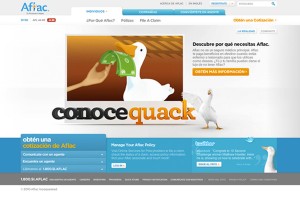
Click on image to enlarge
Photo: Aflac
Last month, Aflac launched a Spanish language website targeting Spanish dominant Latinos in the United States. The provider of guaranteed-renewable insurance seeks to offer “the same quality of interaction and experience, as we offer on our English site.” The development of the English site began in summer 2009 and was launched January 2010; the development of the Spanish language site began the last quarter of 2009. The interactive Spanish-language pages were designed “to inform Hispanic consumers in a culturally relevant way about how Aflac is different from other types of insurance.”
A team with members from New Media, IT, and Emerging Markets departments worked closely with staff from Conexión and FirstBorn, the company’s public relations and digital agencies respectively. The Spanish language website invites visitors to discover why they should purchase its insurance services, and link for visitors to find and communicate with an agent. A section titled Nuestras Historias (Our Stories) features videos of five women and three men agents in California, Florida, New York and Texas who discuss their work with the company.
In addition to press releases the company is planning to promote the new Spanish language website, aflacenespanol.com, to its primary audiences: consumers, business owners and bilingual recruits for the remainder of this year. According to a company representative, the online strategies they have in mind differ by target group and include SEM (search engine marketing), banner ads, and email marketing.
When asked by email how many visitors they anticipate on the Spanish language website a company representative responded: “We expect the site to be well received by Spanish speakers and are putting significant efforts to promote it. At this point, we are building traction and are looking at this as a long term investment in the Hispanic community. It is a bit early to speculate on specific traffic goals.”
According to Aflac.com, 70 percent of employees at the insurance company are women. Women account for more than half of the company’s management and 30 percent of senior executives. The site indicates minorities make up over 40 percent of the company workforce.
Aflac is short for American Family Life Assurance Company. Established by brothers John, Paul and Bill Amos in 1955, Aflac is a Fortune 500 company incorporated is an international holding company based in Columbus, Georgia. The company, the insurer of 50 million people worldwide according to its website, has a presence in all 50 United States and U.S. Territories as well as more than 75,300 licensed agents; it had assets at the end of 2009 of more than $84 billion and annual revenues of more than $18 billion.
Posted by Elena del Valle on June 7, 2010
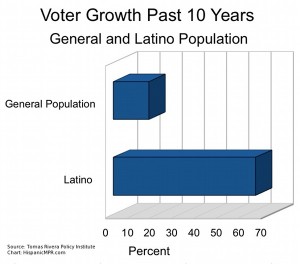
Click on image to enlarge
Photo: Tomas Rivera Policy Institute
In the past ten years the Hispanic vote has increased 64 percent from 5.9 million to 9.7 million voters. Compared to the overall population of over 300 million that may not seem like much. On the other hand, the vote of the general population has only increased 16 percent in that same time period. If that growth pattern continues in the decades to come Hispanic voters will have an increasingly loud voice in political matters.
What impact will Hispanic voters have on future elections? For years political candidates, seers, and pundits have speculated and tried to curry favor among Latinos. As the Latino population grows, especially United States born Hispanics and naturalized citizens and their children who are able to vote, this question will become more relevant. Lately, given the increasingly controversial immigration and immigration enforcement issues facing the nation and Latino’s strong stance on them Latino voter participation may be more noticeable than ever.
Last week, the Tomás Rivera Policy Institute at the University of Southern California (TRPI) released new data that addresses the potential importance of the Latino vote in some states. The Institute researchers examined data from the United States Census for the 2008 elections to estimate the percent of the Hispanic vote it would take to cause a 1 percent shift in the statewide election in the eight states with the largest Hispanic population. According to their analysis, a shift of 2.3 percent of Hispanic voters in California to another statewide party or candidate “results in that candidate increasing their percent of the overall vote and conversely decreasing the percentage of the vote for the opposing candidate.”
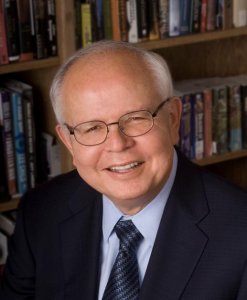
Harry Pachon, president, Tomas Rivera Policy Institute
“Various national surveys indicate that while sixty plus percent of the general electorate favor local immigration enforcement, close to three out of four Hispanics oppose such policies due to fear of discrimination,” said Harry Pachon, PhD, president, Tomás Rivera Policy Institute. “Will Hispanic voters remember this issue in the fall and associate it with parties or candidates when general elections are held in November?”
Founded in 1985, the Tomás Rivera Policy Institute (TRPI) mission is to advance informed policy on “key issues affecting Latino communities through objective and timely research contributing to the betterment of the nation.” TRPI is an affiliated research unit of the University of Southern California School of Policy, Planning, and Development, and is associated with the Institute for Social and Economic Research and Policy at Columbia University.
Posted by Elena del Valle on May 19, 2010

New York City is among the major cities drawing new white residents
Photos: New York City Department of Parks and Recreation, Wikimedia
Many Americans may be surprised to know that since 2000 most of the growth in our country, 83 percent, has been driven by minorities. Researchers estimate that by the middle of this century today’s minorities will be the majority of the country’s population. Already the majority of children in large cities is from minorities. At the same time, there are significant changes in the demographic breakdown of our 100 largest urban and suburban areas. Although during the recession fewer people are moving than during normal times in the last years there have been population shifts worth noting.
I first heard about the trend toward urban center renewal during a podcast interview with Steve Bergsman, author, After The Fall: Opportunities and Strategies for Real Estate Investing in the Coming Decade earlier this year (see Listen to interview with Author Steve Bergsman) One of the changes in America’s demographic distribution in the coming years, he said, would be a renewed interest in urban centers and a falling out of favor of suburbs. According to Steve, this urban regrowth would be driven in part by the high price of gasoline. He has been proven right, at least in the major metropolitan areas of our country where many people are being drawn to live.
A recent Brookings Institution analysis of census data between 2000 and 2008 indicates many young whites are heading to the cities in search of employment, public transportation and city ambiance while Asians, Hispanics and blacks are increasingly found in the country’s suburbs. Although the suburbs are still identified as white for the first time a majority of racial and ethnic groups in large metropolitan areas lives outside the cities.

Washington D.C.’s white resident population grew 5 percentage points
The suburbs continue to be the home of Baby Boomers aged 55 to 64 and now claim a large percent of a less desirable demographic for marketers, the poor. Surprisingly, the suburbs are where the largest poor population in the country can be found. Of course, the changes do not affect all cities. According to May 9, 2010 The Associated Press article, Washington, D.C. and Atlanta gained the most whites (5 percentage points each) followed by New York, San Francisco, and Boston. Other cities in the white flight scope include Portland, Oregon, Raleigh, North Carolina and Austin, Texas.
The Brookings Institution, a nonprofit public policy organization based in Washington, D.C., is dedicated to conducting research to advance three goals: “Strengthen American democracy; foster the economic and social welfare, security and opportunity of all Americans and; secure a more open, safe, prosperous and cooperative international system.”
Posted by Elena del Valle on May 17, 2010
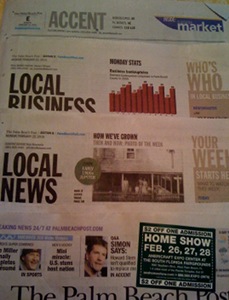
Staff cuts not withstanding many media outlets have survived the transition from traditional formats to today’s multimedia mix. It may be that the new formats brought some changes for the better such as increased efficiency. For example, at some media outlets a single enterprising young journalist reports, produces and captures video footage for his or her story. And newspaper editors express satisfaction with the new technology oriented staff that have been brought on board in recent years and their willingness to try new things.
In spite of that future funding is a source of concern for many news executives when it comes to the long term viability of their media outlets, according to a recent study. Alternative funding options, including government financing, are not appealing for them and they worry about their outlet’s survival over the next decade unless they are able to figure out a viable source of funding to replace the old business model.
Two thirds of survey respondents had serious reservations about receiving government subsidies and 78 percent were not interested in accepting funding from interest groups. About 50 percent were worried about funds from government tax credits and more 33 percent had doubts about private donations.
Online most of the media efforts are focused, according to the participants in the survey, on traditional sources of revenue such as display and banner ads. These remain the main area of effort and the one survey respondents had the highest hopes would yield results. Another area under consideration was revenue from products outside of news.
The results of the survey, conducted by Pew Research Center’s Project for Excellence in Journalism in association with the American Society of News Editors (ASNE) and the Radio Television Digital News Association (RTDNA), were released last month.
“Our mantra this year is experiment and fail quickly,” said a newspaper news executive who participated in the survey. “Don’t be afraid of change and don’t stick with something too long if it doesn’t work.”
“Outside funding options are a bad idea overall,” said a broadcast news executive survey respondent. “They are being used to ‘save’ old models of journalism that are no longer economically viable and will die out over time no matter what.”
Interestingly, there were significant differences between the attitudes of survey respondents from newspaper-based newsrooms and those of broadcast outlets including their view of journalism’s future. Broadcast news executives were more pessimistic with almost twice as many respondents who viewed journalism as headed in the wrong direction compared to those who thought it is headed in the right direction. Newspaper news executives were slightly more optimistic.
Many executives in marketing, advertising and public relations may believe the future of media is closely linked to their career future and seek an understanding of the possible direction of print and broadcast media to better serve their clients and their professional futures.
The researchers received responses from 353 journalism executives from the ASNE or RTDNA membership lists after inviting them to participate in the online survey by email between December 2009 through January 2010. Of the 353 news executives 36 percent were ASNE members and 24 percent were RTDNA members.
Posted by Elena del Valle on May 5, 2010

An iPhone
Photos: Apple, Motorola
Once upon a time there was print media. Then came radio and television. The Internet changed our world and marketing along with it. Now we can listen to some radio programs and watch television shows online whenever we want. The media have fragmented.
That’s before even mentioning ethnic media outlets. Or, dare I say it, the newly available and much anticipated iPad which threatens to change book and magazine publishing, among other things. At the same time, there is a device nearly everyone has and carries with them most of the time, cellphones. Mobile phones have become ubiquitous in our country and in many parts of the world, presenting a wide open marketing window of opportunity.
By the end of this year, there will be 5 billion mobile phone subscriptions world wide, according to a February 18, 2010 The Economist online article. Many mobile phone conversations are lasting longer than they did in the past. Ten years ago cellphone users spoke for an average 174 minutes a month, according to the GSM Association, an industry group. That average had reached 288 minutes by September 2009.

A Motorola Droid
Some places have chattier users that others. For example, people in Puerto Rico talk the most, 1,866 minutes according the GSM Association. This may be because cheap plans include unlimited calls to the American mainland where family and friends are often based. On the continent, Americans are using 835 minutes (including incoming minutes paid for by the subscriber). Others among at the top of the list of heavy users are Hong Kong, China, Uzbekistan, Singapore, India, Canada, Israel, and Belarus. The three lowest users? Sao Tome and Principe, Cambodia and Philippines.
Who is using mobile phones in America? It seems everyone old enough to use one has a phone or some people have more than one. In the three month average ending in February 2010, 234 million Americans 13 years of age and older were mobile subscribers, according to comScore MobiLens data released last month. Since there are just over 300 million people living in the United States including babies and children, 234 million is a high percentage of the population that is capable and old enough to have a phone.
Although the comScore study does not breakdown use by ethnic group, US Hispanic Use of Telecommunication Services 2006 – 2011, a market research report by The Insight Research Corporation, examines mobile phone use by blacks, Hispanics and Asians in the United States. That organization’s researchers estimated that one out of every three dollars spent on telecommunications services in 2009 would be purchased by domestic ethic communities.
A March 2009 Scarborough Research report indicates Hispanics like cellphones, are more likely than the average person to have a cellphone, and outspend many others on cellular usage. Members of this market segment also tend to use the phone’s functions beyond talking, often taking advantage of picture taking, text messaging, email, Internet access and downloading applications.
Posted by Elena del Valle on April 21, 2010
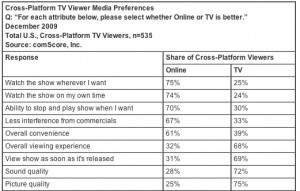
Click on image to enlarge
Photo, chart: comScore
According to a study released last month, people who watch television online are young (54 percent are 35 years old and under), likely to watch programs where and when they choose and more tolerant of ads than regular television viewers. Study participants were asked questions designed to assess their tolerance of advertising (based on one minute increments from 0-15 minutes) when watching one hour of TV programming on the Internet. Analysts determined the highest tolerance for online TV watchers was between six and seven minutes per hour which is much higher than the four minutes per hour of ads delivered online as part of TV content.
Although survey respondents thought sound and picture quality were better on television, most participants in the study, 75 percent, said they choose to watch TV programming online because it is possible to watch it wherever they want (within the United States as many televisions programs are not available online in foreign countries); 74 percent said they do so because they can watch the shows whenever they want; 70 percent preferred watching television programs online because of the stop and play option; and 67 because there is less commercial interference.

Tania Yuki, director, online video and cross-platform product at comScore
“As cross-platform TV viewing becomes more widely adopted, it is important to understand the driving forces behind this shift in consumer behavior if we are to effectively monetize this emerging medium,” said Tania Yuki, comScore director of online video and cross-platform product, in a press release. “While some analysts have suggested that the shift to online video reflects a consumer desire to view fewer ads, our research suggests that in many cases online TV viewers actually have a higher tolerance for advertising messages than they are currently receiving. This finding, of course, suggests there’s advertising revenue being left on the table and that media companies have not yet extracted full value out of the online medium.”
Young TV viewers among the survey respondents said they are most likely to watch television programs at the time of their choosing; only 35 percent of viewers age 18-24 (25-34 year olds behaved similarly) said they watched episodes live; 42 percent said they watched programs at a different time within one week of the original air date and 23 percent said they watched the programs more than one week after the original air date.
Researchers in the comScore study distinguished three segments of television programming viewers. Those who only watched television, TV-only viewers, (65 percent); those that watched television programs on television and online, cross-platform viewers (29 percent); and those who watched televisions programs only online, online-only viewers (6 percent). Study analysts compared the attitude differences between the three groups. The study, based on a survey of more than 1,800 U.S. Internet users who watch originally scripted TV content, was first presented by Tania Yuki at the ARF Re:think conference on March 23, 2010.
According to a comScore spokesperson the study did not include ethnic profiling. However, independent data suggests Hispanics skew young as a demographic group and over index in the use of the internet, making it possible, even likely, the findings of the study apply to Hispanics who watch television programs online.
Posted by Elena del Valle on April 7, 2010
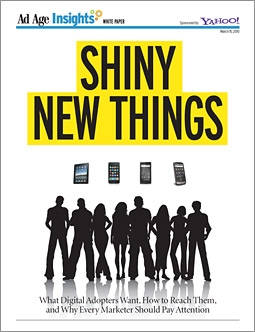
Photo: AdAge
For six weeks Laura Rich researched early adopters of digital technology focusing on their use and purchase of mobile devices, software, computers and televisions. She believes they play a pivotal role for companies introducing new products into the marketplace and highlights that this group of white men, mostly, “can be identified by what they do, not who they are.” Although she identified studies that indicate Latinos often take advantage of digital technologies at rates higher than the general market; what matters more than their race and gender and where they work (often technology companies), she points out in a white paper, is their use of information, and the way they buy products and share their opinions with like minded others.
These opinions can affect the acceptance or rejection of a new product into the market. Aware that their opinions matter these first users of technology products want to be heard by marketers and product makers, she says. Win their favor and you gain an advantage; risk their displeasure and prepare for the consequences, she points out illustrating with examples from well known companies such as Apple, Google, and AT&T.
The staff writer at AdAge shared her findings in Shiny New Things: What Digital Adopters Want, How to Reach Them, and Why Every Marketer Should Pay Attention, a white paper about what would be “most relevant to marketers wanting to reach this crowd.” She concluded early adopters are “opinion leaders” who play a key role in marketing. They are highly educated, have a higher social status and earn higher incomes than traditional consumers. They are often risk takers with high standards for products and companies and are more critical than regular consumers. Many are status seekers who value information more than most other consumers.
Based on her research, she concluded that thanks to the boom in social media, early adopters have a high potential to influence products, especially gadgets and online brands, she describes as “screen power.” Their influence is, she believes, is becoming evident in mega social media sites such as Twitter and Facebook.
According to her findings, 62 percent of early adopters will consider upgrading their mobile phone when a new model is released; 68 percent may have purchased three or more computers in the past two years; and 58 percent are more likely to have purchased three or more flat-screen TV’s in the past two years.
In the white paper, she quoted findings from Pew Internet and American Life and Yahoo! studies that outline digital technology use by ethnic groups. A Yahoo! study indicates Hispanics over index in their adoption of technology and media consumption compared to the general population.
A study by Yahoo!, Telemundo and Experian Simmons Research, she mentions, indicates more than two thirds of respondents had been online for more than five years; 90 percent have a cell phone (compared to 79 percent of the general population); 66 like to send text messages (compared to 38 percent of the general population; although only 61 percent had taken photos with a cell phone (compared to 79 percent of the general population.
























